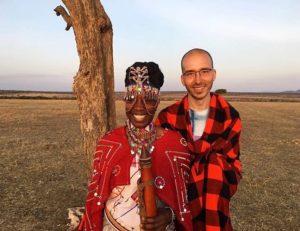Tell me something I don’t know!
Communication
Sometimes textiles can be used to say very specific things. You can show support for a political party, or your country, or you can give the world advice on how it should behave. Symbols on textiles are used in different ways. They can promote good fortune or represent traditional stories or ideas.
Audrey Migot
Audrey Migot was born in Kenya and moved to Bristol from Edinburgh in 2011. She is the director of Yala Studio Ltd, an ethical and sustainable brand inspired by her Kenyan heritage. Yala specialises in handmade beaded jewellery, small accessories and bespoke clothing using African fabrics. Her interest in fashion and heritage are explored through the blog on her website and social media channels.
Wedding Dress
My husband and I were together for 16 years before we decided to get married. As we each come from very large families, we realised in horror that we would have to get married twice, once in the UK and once in Kenya. Despite having lived in the UK for many years, I am fiercely proud to be Kenyan and it never occurred to me to wear a white dress. Our first wedding in Bristol presented the perfect opportunity to celebrate and showcase my African heritage.
I love to sew and decided the best way to execute my vision would be to make the dress myself. I spent a weekend in London with a friend, sourcing the fabric, which took a while as I wanted particular colours but in a design that would work visually once the fabric was cut into sections. I then approached my dress making teacher Karen for help with construction .Karen was simply fantastic. She helped me with the design, drafted a pattern and supervised the creation of the dress from start to finish. I can’t thank her enough. The other Kenyan attendees at the wedding also dressed in typical African attire to represent our heritage and to further communicate our pride.

© Joseph Hall
Our wedding in Nairobi was the same year a few months later. And due to the heat, I had a shorter dress to change into for the evening. I had sourced the fabric earlier in the year with my mum and the bright colour was something I would never have chosen for the UK wedding but it was perfect for Kenya as it would fit right in amongst the other bright colours of the guest’s clothing. The dress was designed by me and sewn by our family friend Sheila Madoka. She took it upon herself to add all the stunning beading at the neckline which was all done entirely by hand.
We actually had a third wedding, although it was a total surprise and neither of us knew it was happening until the day. We were in Naboisho Conservancy, just outside the Maasai Mara and members of the community who my mum works with knew that we were getting married and wanted to participate in some way. So they drove us out to the middle of nowhere under a tree where two Massai elders performed a traditional ceremony and I was dressed up and decked out in full Massai wedding regalia. Complete with headdress and necklaces and beads galore. The shawl was made by a group of Massai women and given to me as a wedding gift. Understandably it’s priceless and irreplaceable and we were incredibly moved and grateful.
Our guests from the UK were privileged and delighted to be a part of it. Especially because they will probably never witness something like it again. Also, I’m not even from the Massai tribe… I’m Anlo-Ewe. So the privilege is even more profound.
Kangas
The writing on a kanga is called the jina and is typically a Swahili proverb or a saying. Often when read or translated literally, they make no sense as the meaning can be deep and convoluted. For this reason, clothing made from Kanga fabric should be worn with care and consideration so as not to cause offence. On the other hand, some Swahili proverbs are exactly replicated in English. My personal favourite is:
paka akiondoka, panya hutawala: when the cat’s away, the mice will play.
Whenever I buy new kangas, I get help to try and translate the proverbs from my family and we scratch our heads together to decipher the correct meaning.
In contemporary Kenya, kangas are used in many ways: clothing, cushions, beach towels, apparel, bedding and decoration. The basic design is the same but the colours and patterns change often. As they are almost never reprinted, once a design Is sold out, it’s gone forever. For me, this only adds to their appeal.
African Sayings
hata mkijua yatawafaa nini: even if you know, how will it help you?
mimi silipizi ubaya mwenyewe utaona: if you cross me, you’ll get what’s coming.
kuombeana dua ni kheri: saying a prayer for another is a good thing.
nimeona wengi lakini sikama wewe: I’ve seen many but none like you.
African Fabrics
What I love about African fabrics, whether it’s East African, West African or wax print, is that they’re so versatile. I’ve made cushions, lampshades, bags and clothing in a multitude of prints and colours. For clothes, the fabric can be sewn into something formal or causal, traditional or contemporary and the limited print runs means that unlike high-street clothes, you won’t see everyone wearing the same thing as you.
My greatest wish would be for people who aren’t of African descent to realise that they can wear these fabrics too. People often say to me ‘I’m too pale’, ‘the colours are so bright, it wouldn’t look right’ and I say nonsense. If you like it, wear it and look fabulous.